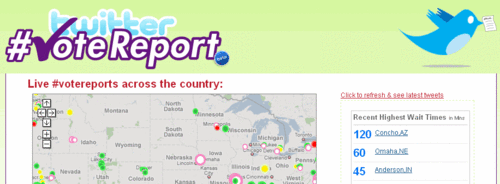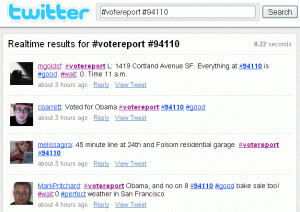 Among the coverage of yesterday’s remarkable presidential election is yet another remarkable application of the microblogging platform Twitter: a sort of nationwide team-based journalism exercise to report on potential problems at polling places.
Among the coverage of yesterday’s remarkable presidential election is yet another remarkable application of the microblogging platform Twitter: a sort of nationwide team-based journalism exercise to report on potential problems at polling places.
The Twitter Vote Report project enlisted a slice of that very large crowd of folks who cast their ballots on Tuesday to monitor moods, wait times, irregularities, and many other indicators of how the voting process went.
Volunteers sent in field reports via their Twitter feeds or by texting on cellphones and other mobile applications. Vote Report invented a few “hash tags” for the occasion to facilitate the concise updates: “#votereport” to tag the message as an official field report, “#good” for no problems, “#wait” to report delays in getting into a booth, “#machine” to signal trouble with voting machines, and so on. (For more details on the hash tags, see Vote Report’s explanation of how to participate.)
Various Web-based tools, some pre-existing and some created just for this project, enabled viewers to tune in to and follow the ups and downs all over the country. It was pretty amazing to watch the national flood of “tweets” in real time.
 At a more local level, here, at right, is what a query for our neighborhood zip code turned up on Twitter Search. (How’d we miss the bake sale?)
At a more local level, here, at right, is what a query for our neighborhood zip code turned up on Twitter Search. (How’d we miss the bake sale?)
Sporadic peeks at Twitter Vote Report yesterday suggested that despite isolated missteps, for the most part the voting went smoothly. We may hear more as folks pore over the streams.
But regardless of what the effort turned up, it’s how the project tackled this reporting job that should interest Web publishers. Once again, social media and crowdsourcing point in some tantalizing directions.
What can your crowd help you report on?



